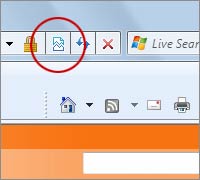IE Finally Follows Standards – What does it mean for your visitors?
![]() Microsoft released Internet Explorer 8 (IE8) in March, and although its deployment has been slow, the new browser has created a potential concern for designers and developers.
Microsoft released Internet Explorer 8 (IE8) in March, and although its deployment has been slow, the new browser has created a potential concern for designers and developers.
The new browser introduces a slew of fundamental improvements, including security, ease of use, and support for RSS, CSS, and Ajax. Most noteworthy in IE8, however, are the significant changes in the way pages are rendered. In contrast to previous versions of IE, Microsoft has made a gallant effort in IE8 to render pages in greater conformity to web standards.

Although standardization enables consistent development across browser platforms, sites designed for older versions of IE may not display as intended in IE8. (Learn about rendering in IE at Microsoft’s IE Compatibility Center.)
To mitigate display issues, Microsoft has introduced in IE8 a “compatibility view” that enables sites to revert back to IE7 rendering. It’s a quick fix that enables webmasters to punt on the IE8 rendering changes. To force display in compatibility view, simply add the following meta-element to your pages:
<meta http-equiv=”X-UA-Compatible” content=”IE=EmulateIE7″ />
Since other browsers will ignore this code, Microsoft suggests this approach has the best blend of allowing web developers to easily write code to interoperable web standards while not causing compatibility problems with current content.
You can also address this issue by adding HTTP Response Headers in IIS6 or IIS7 [read]. This is very convenient for any web developers that have static sites.
